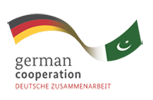Project: Introducing new technology and techniques in leather products’ design and manufacturing
Project Duration: Nov 2013 – Sept 2015
Context
Leather production is the second biggest export-oriented manufacturing sector and ranks third in overall exports of Pakistan. The industry has a production capacity of more than 100 million square meters, however actual production is only 60 million square meters. This underutilization of existing capacity is because of power outages, absence of energy efficient technologies, lack of qualified maintenance technicians and lack of skilled workforce for the industry. As a result, Pakistan faces a 3.94 % decline in leather goods exports (fiscal year 2011-2012).
In light of this analysis, the Government of Pakistan has approved to establish a “Tannery Zone”/industrial park in Sialkot. It is expected that the respective area will grow to accommodate around 550 leather and leather products companies.The current number of leather manufacturing units is estimated to more than 1000 in and around Sialkot.
The project is being implemented by the Pakistan Gloves Manufacturers and Exporters Association (PGMEA) through its Leather Product Development (training) Institute (LPDI). The project is supported by the TVET Reform Support Programme as part of the Fund for Innovative Training (FIT) component. The TVET Reform Support Programme is co-financed by the European Union, the Embassy of the Kingdom of the Netherlands, and the Federal Republic of Germany and administered by the Deutsche Gesellschaft für Internationale Zusammenarbeit (GIZ).
Project Objectives
• Introduce new technology and techniques in leather products design and manufacturing
• Produce skilled labour for the leather industry in Sialkot
Target Group
• 630 unemployed youth (pre-employment training); → poor (less than Rs. 10,000/- per month for a household size of 6 people) unskilled and no access to education and training facilities
• 840 existing workers in the leather industry who intend to improve their skills and expertise (in-employment training)
• 480 business managers/owners (In each of the above sub-group male and female participants are targeted but no numbers are given)
Methodology
• Upgrading infrastructural facilities at LPDI
• Hiring international experts (4-6 weeks) for capacity building in production management and techniques, use of energy efficient technologies,modern design, skill development (stitching, cutting and pattern making), and quality standards
o Selection of experts through gathering information from Pakistani High Commissions and concerned Chambers of commerce/trade bodies
• Providing seven different courses to 1,470trainees relating to various stages of manufacturing and designing leather products e.g. gloves, garments, sportswear and shoes
o Pre-employment training – 7 full-time courses with 30 trainees each3 batches, followed by 2 month of internship. Regular visit of staff during the internship period so as to provide guidance and ensure that companies are able to impart industry relevant skills. An on the job training logbook will be used to supervise and monitor the progress of each intern
o In-employment training – 7 evening courses with 30 trainees each 4 batches;the focus is on skill enhancement, particularly in using new materials and techniques.
o The proportion of all training is 80% practical and 20% theoretical
• Providing seminars for business managers/owners on modernization of machinery, latest technology,production techniques, innovations, marketing techniques and standards, including compliance with registration evaluation and authorization of chemicals (REACH) and health safety and environment (HSE) standards – 6 seminars with 80 persons each
Expected Outcomes
• Completers find employment
• Enhanced productivity and reduced costs of production in the involved manufacturing units
• Continuation of training using full capacity of LPDY for at least 4 years after project completion
• Common facilities services to the surrounding industries are established
• Income for future training courses is ensured
Contact Details: Mr. Khurram
Email: pgmea@brain.net.pk
 Pakistan TVET REFORM Support Programme Technical and Vocational Education and Training (TVET) Reform support Programme
Pakistan TVET REFORM Support Programme Technical and Vocational Education and Training (TVET) Reform support Programme





